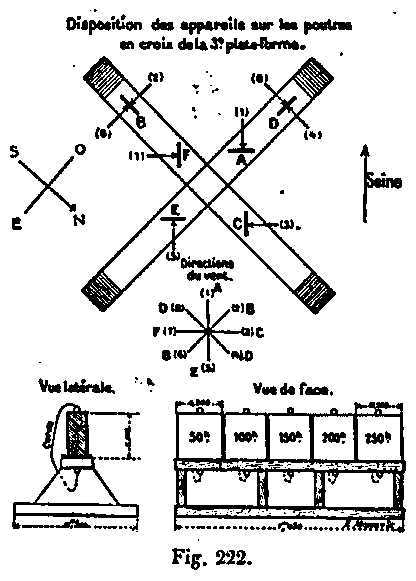It seems obvious to us nowadays, but at the end of the 19th century we did not have precise measuring devices to calculate the pressure that the wind exerts on a building. The Eiffel Tower, by its size, was naturally suitable for experiments on this subject. So it was at its summit that a new kind of apparatus was installed and came to an astonishing conclusion, namely that the resistance of the wind had for a very long time been largely overvalued!
According to the opinion of many meteorologists of the nineteenth century, there were not yet good devices for the direct measurement of pressure, because they are very difficult to orient as soon as they have a little mass, and that they do not obey variations quickly enough; the friction is important and does not remain constant. In the second place, very different results are obtained according to the dimensions of the plate tested and its thickness, because of the important eddies which form behind it. Thus, it is generally preferred to measure the speed and deduce the pressure per square meter, by the known formula P = 0.125 V2. But on the other hand engineers who have studied the stability of constructions under the effect of the wind have often recognized that if the figures given for the pressure of the wind had been reached, a large number of buildings, and in particular certain high chimneys, have been overthrown. There is therefore a certain presumption that the formula above gives exaggerated results.
To make sure of this and to determine at least a maximum, the Society of the Tower, on the proposal of Mr Kochlin, its engineer, had installed apparatuses imagined by him, on the extremities of the large cross beams of the summit.
These devices, numbering six (see Fig. 222, opposite), are arranged so as to be normally windward for eight different directions, that is to say that a device made with the following an angle 45 °. Each apparatus consists of 5 parallelepiped cast iron whose dimensions and stability are calculated so that they are reversed by a wind of a given intensity. These blocks, made with great care as exactness of the dimensions and sharpness of the edges, are placed next to each other; they are established to be overturned, one under an effort of 50 kg per square meter, the others under increasing efforts of 100, 150, 200 and 250 kg. For this purpose, their dimensions are 0.20 x 0.20 on the surface and the thicknesses are 97.4, 52.8, 64.7, 75 and 83.5 mm. They are arranged on a light frame forming a raised shelf of 0.25 m carried by feet between which the wind passes freely. The results obtained by the apparatuses which give to the nearest 50 kg the maximum effort sought provide exact indications, at least as regards the force which produced the reversal, since a known moment of stability is involved. can only be destroyed by a determined effort. An iron chain prevents the blocks from being thrown off.

However, under the great storm of 1894, the anemometers recorded a speed of 45 m per second which represents per square meter a force of 253 kg, if one adopts the coefficient K = 0.125. If this coefficient were correct, all the blocks would have had to be tumbled. On the contrary, with the coefficient of 0.07 determined by the experiments of MM. Cailletet and Colardeau (see the experiments on the resistance of objects in the air ), the maximum effort is only 141,75 kg per square meter, so only two blocks had to be knocked down. It is precisely this last case which arose: the blocks of 50 and 100 kg were only reversed, and the others remained standing. The wind pressure remained below 150 kg instead of the 255 kg that could be expected.
These conclusions are, from the practical point of view, very satisfactory and give peace of mind about the pressures adopted in the calculations of metal constructions in general and the Tower in particular; they show that these pressures are exaggerated. We must add that it was the only time, on November 12, 1894, that the 100 kg block fell. That of 50 kg, on the contrary, was frequently tumbled for average speeds of 16 to 25 m given by the recorders; which shows that the maximum speeds not recorded could be noticeably higher. With the coefficient of 0.070, the speeds corresponding to the pressures are as follows:
- P = 50 Kg V = 26,7 m
- P = 100 Kg V = 37,7 m
- P = 150 Kg V = 46,0 m
- P = 200 Kg V = 53,4 m
- P = 250 Kg V = 59,6 m
These last speeds never being reached, it would be advantageous to remove the blocks of 200 and 250 Kg and to insert new blocks for 25, 75 and 125 Kg, so as to obtain closer results. This is probably what we will achieve in an upcoming installation, where we propose to further elevate the blocks above the lower obstacles, trying to orient them in the exact direction of the wind.
As for the eddies that occur on the opposite side of the wind and have a tendency to decrease the overturning effort, creating a sort of void back, it will probably be easy to find provisions to remove them. It should be noted, however, that they occur in the most frequent cases of the practice, at least as regards the metal constructions where the wind meets especially surfaces having a small thickness.
See also:




















